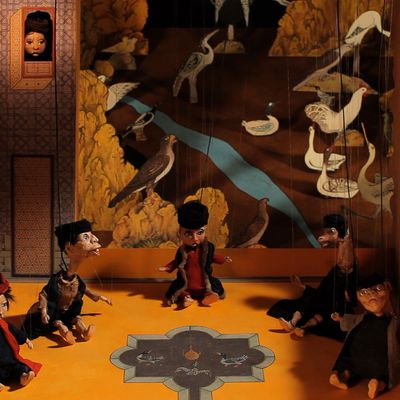
One of the more florid and unfashionable forms an artist can use these days is the epic. Of course, no one denies the greatness of Homer, the Mahabharata, Gilgamesh, The Aeneid, Dante, Milton, or Melville. Few would argue with Philip Glass, Francis Ford Coppola, Nan Goldin’s Ballad of Sexual Dependency, Kara Walker, and maybe Matthew Barney — though he is often castigated and snickered at for his form. Yet these days, the epic is often the domain of the overblown Hollywood blockbuster sequel, pseudo-intellectual serial television dramas, and multipart books about soft-core porn or young-adult coming-of-age or dying stories. Epics are viewed as overwrought, platitudinous, clichéd, swollen with sincerity and melodrama, a form of eras gone by. Not by me: I love epics for how their authors can claim to be channeling muses and deities who speak through them, recounting stupendous narratives. I love art that attempts to be about everything, to catalogue a moral universe, show us a thing from every side, tell a tale with so many levels that the tale is always unfolding.
Egypt-born and -based Wael Shawky inhabits the epic’s structure impeccably, and in the most unexpected way possible: with puppets. In a lush, labyrinthine trilogy of films being exhibited at MoMA PS1, he uses sublimely designed, marvelously costumed ensembles of marionettes and puppets — some made centuries ago, others fashioned by the artist of Murano glass. These imaginary beings act against painted backdrops, in little built cities, citadels, and battlements; they move in surreal landscapes, speaking Arabic, dancing, singing. With his supernal sense of sound, staging, pacing, and color, Shawky uses these puppets and backdrops to transmit the horror, hate, vanity, slander, and circles of hell of the clash between civilizations known as the Crusades. We watch tragedies unfolding that cannot be stopped, waves of ever-worsening invective. Making the films more powerful and timely, everything in them echoes desperately into the present. As organized by Klaus Biesenbach with Margaret Aldredge, the show couldn’t be better, or more ably installed. It is one of the best exhibitions of the season.
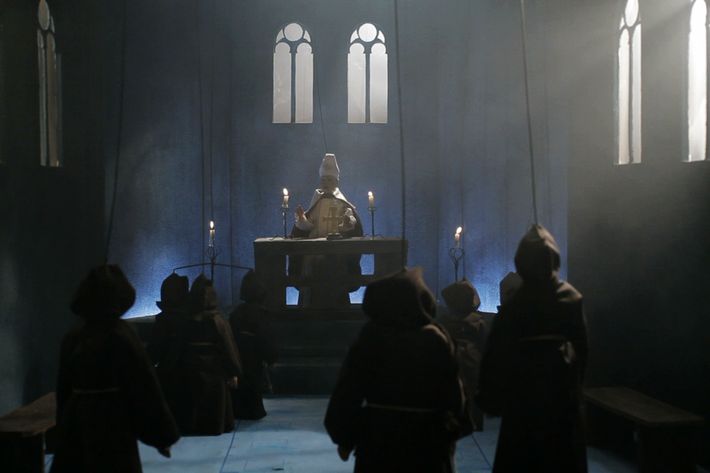
Cabaret Crusades gives us the crusades as seen through an Arab perspective, based as it is on essays by contemporary Lebanese historian Amin Maalouf. The first two films of Cabaret Crusades are The Horror Show File and The Path to Cairo — 32 and 58 minutes, respectively, made in 2010 and 2012. They are the most intoxicating, savage masterpieces of the Crusades I’ve seen anywhere, on film or otherwise. Each film opens with a spectacular shot. Part II begins in 1099 with Jerusalem burning. Between 60,000 and 100,000 Crusaders have taken and ransacked the holy city. The conflagration is reminiscent of the incredible opening shot of Apocalypse Now — Jim Morrison singing “The End” against a Vietnamese jungle erupting into fire. After a prologue scene of plague-ravaged Constantinople, Part I gives us the fateful day of November 27, 1095, and Pope Urban II in France calling on all European Christians to fight against Muslims to reclaim the holy land. “God wills it,” he proclaims. This sets in motion a story that unspools still. Even the places in Shawky’s films are sickeningly familiar: Aleppo and Damascus in Syria, Mossul and Baghdad in Iraq, Mecca, Cairo, Lebanon, Palestine, and, of course, Jerusalem. Although the films only encompass a little more than 55 years, Shawky brilliantly makes this time frame feel endless, shot through with delusion, hubris, and power-mad folly.
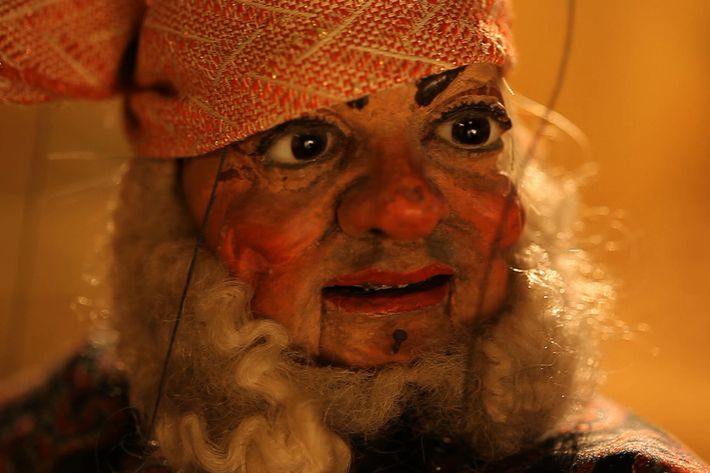
The show includes three enormous vitrines displaying scores of the puppets used in the films. These beautiful sculptures seen en masse triggered wistful wishing that I’d spent more of my life watching puppets. In the films the figures truly come alive: Shawky and his puppeteers are masters of nuanced body language. Marionettes move almost in slowmotion, strings always visible. Yet somehow these levels of artifice become more real than actors acting. Eyes blink in 1,000-mile stares; mouths click-clack open and closed, never synched with words; hands motion in circles; animals stand looking aimlessly about. The animals are our entry points; we helplessly look on. Shawky is a connoisseur of sulking, sullenness, suffering, telling this tale of the beginning, of never forgetting, of blood libels and vengeance.
As with many epics, there are scenes recounting marriages, deaths, and ritual moments in cosmic detail; feasting; sleepless nights; celebration. Maybe only puppets can give us these things too big to grasp otherwise. There’s great oratorical prowess here, too, highly stylized forms of address: elegies, epitaphs, hymns, laments, oaths, pleas, prayers, and prophecies — all would seem cheesy if delivered by actors. Best are the scenes delivered in song. The action stops as a character breaks into rhythmic dirge or ecstatic aria delivered to drums and other exotic instruments. (I imagined Wagner’s “Ring Cycle” done with puppets.) Characters beseech deities, beg forgiveness, bid farewell to families, and sentence loved ones to death. Even small scenes can shatter. In one sequence, the Pope’s forces march through Germany and decide to kill all Jews. So go these holy warriors.
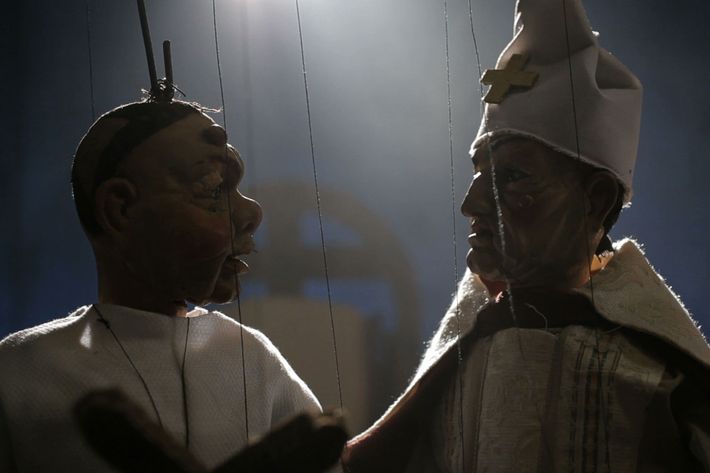
We also witness endless Muslim plots upon other Muslims, sect upon sect, Sunni versus Shia, potentates betraying each other, sending assassins to kill leaders and children, murdering their own families, ransacking one another’s cities. There are no heroes in Shawky’s art of anticlimaxes, no resolutions. His is an epic of grandeur with intensity, just continuous houses of death.
Part III, Secrets of Karbala, is as beautiful as the first two films. But at two hours — and, seemingly, with a much bigger budget — most of Shawky’s attention here looks like it went into the puppets and sets. Action becomes monotonous; the script is all stalemate; the film fizzles. I hope Shawky takes up the story one more time, if only to provide a better bookend to this otherwise brilliant series.
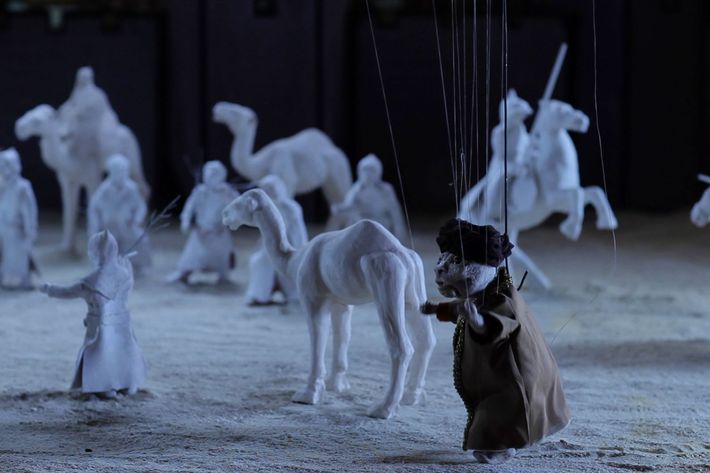
Two other things about this show make this exhibition pressing. The first may be banal but is important in art world circles. Cabaret Crusades reminds us that Klaus Biesenbach is fine at what he does best: making shows and projects like this at PS1. His surveys of Ryan Trecartin and Laurel Nakadate; his “Fassbinder Berlin Alexanderplatz”; the 2000 “Disasters of War” he organized, pairing Jake and Dinos Chapman with Henry Darger; and his 2013 group show about ecological changes were all good. But it needs to be made plain as day: Biesenbach is not a scholar or an intellect, maybe not even a curator, per se; he’s an impresario who has been given too much power at MoMA. Starting with his 2010 Mariana Abramovic show, he’s had a deleterious effect on the museum, culminating with this season’s Björk debacle. No matter, he can be good at this sort of show.
Far darker, seeing Cabaret Crusades made me remember how the past is never past. Watching Shawky’s characters forever recounting the reasons for their killing, I remembered a reporter once asking a Bosnian warlord how a particular skirmish began and hearing him flatly begin, “Well, back in 1385 …” Shawky’s films remind us that only one day after September 11, 2001, George W. Bush called for a “crusade.” Almost echoing Pope Urban II, he incited the West to “defend freedom and all that is good and just in the world.” Shawky’s art makes us know this in our bones, makes us wonder if we’re addicted to and in satanic love with war. After thousands of years, the words attributed to Plato only ring truer: “Only the dead have seen the end of war.”
*A version of this article appears in the July 27, 2015 issue of New York Magazine.




